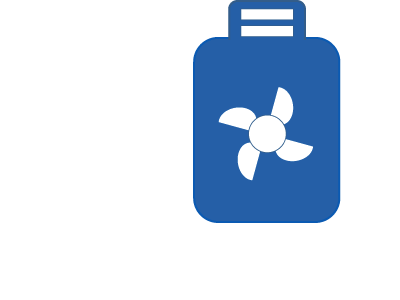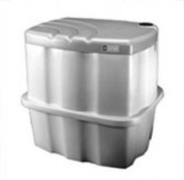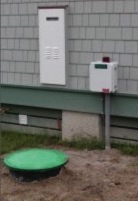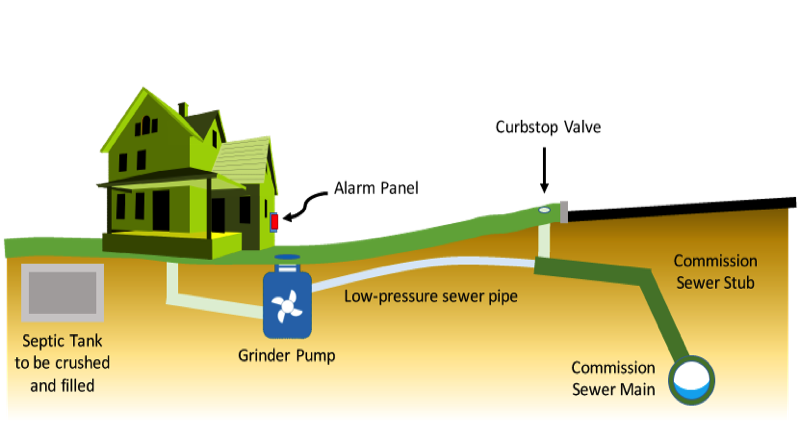On most properties, deploying traditional gravity sewage systems poses few problems. But for difficult terrain, gravity sewage removal can pose several problems. The most typical problem is that because of site conditions the sewer main is too shallow in the road to connect to it from a house and still maintain positive pitch. This means that effluent would flow back into the house from the road. Additionally, there is some areas and streets that have houses located in areas that are lower than the main trunk line.
There are several options to deal with these problems:
1. If there are many houses clustered in an area that have the same problem, then a pump station or a low pressure sewer, utilizing grinder pumps, is used. Which option used is determined by the number of houses requiring service.
2. When a single house is set lower then the road a grinder pump is used.
Grinder Pump Guide

Grinder pumps are specialized pumps that grind up effluent and then pumps it up hill to discharge into a gravity sewer. The wastewater moves in small, 1 1/4 inch diameter, pipes installed below the frost line, making this method ideal for difficult terrain. A technology available since the late 1960s, grinder pumps are cheaper and more flexible than traditional gravity sewer systems.
Models
The LSDC has designed the system to accommodate a variety of common models including Barnes, F.E. Myers, an Environment One pump, or an approved equal. These companies have been in the business for many years and are considered to be front runners in grinder pump technology.
The LSDC has specially designed the system to the specifications required for these pumps. The standard model pump chosen by the LSDC is an all-in-one unit installed outside of the home.
These pumps perform the same basic task of grinding and pumping effluent from the home. The significant difference between the E/One brand and the Myers brand is the pump itself. The E/One brand uses a semi-positive displacement pump while the Myers brand uses a power centrifugal pump. The housing for both pumps is very durable with the E/One being made of high density polyethylene (HDPE) and the Myers being made from spun fiberglass. Each is designed to provide some limited storage in the event of power loss but you should try to conserve water use during such events.

Installation
If you need a grinder pump you are required to use either the E/One or Myers brand pumps or an approved equal. When a household is ready to make a connection they must file for General Service indicating that they require a Grinder Pump. The specifications for the model of grinder pump chosen must be pre-approved by the LSDC prior to installation.
The homeowner is required to use a drainlayer who is licensed and approved by the LSDC to perform the installation. If needed, the LSDC will provide homeowners with a list of approved drainlayers.
Although these pumps fail infrequently, the pump requires that a switch box with an audible alarm and flasher be mounted on the outside of the house within view of the pump. This is needed for emergencies, such as pump failure. This portion of the installation needs to be performed by a licensed electrician. Usually this can be coordinated through the drainlayer that you hire.
The pump is approximately 6 feet tall out of the ground but when installed, only the top 6 to 10 inches is visible and can easily be concealed by plantings. It is often likened to look like a trash can cover left on the ground.
Because the Myers pump uses your homes internal plumbing system for ventilation it can be fully buried, although the LSDC does not recommend burial because of the need for periodic maintenance. The E/One pump cannot be fully buried because it has openings that need to be exposed for proper ventilation and maintenance. There should be no odors coming from the pump.

Cutaway view of a E/One Grinder Pump
Cutaway view of a Myers Grinder Pump
E/One Interior Grinder Pump
In recent years, manufactures have also developed interior grinder pump models. These units are typically 100 gallon capacity tanks and have similar features as the exterior grinder units. These units offer the advantage of having no exterior components that may interfere with landscaping features and can sometimes be easier to install. They are also very easy to service in the event that service is required. One downside that should be considered is that there is a smaller capacity tank than exterior models so backups can occur quickly in the event of a power outage.
Interior grinder units have been installed at several homes in the District for the last five years with no reported issues.
In all cases, homeowners should consult with a design engineer to select a grinder pump system that works best for their home.
Reimbursement for Grinder Pumps in Certain Service Areas
The LSDC has capitalized the expense of grinder pump units as part of the overall cost of the George Hill Road and Center District Project areas for existing homes.
In those areas, the homeowner is responsible for all up-front costs including the purchase of the pump and the installation. However, the LSDC will reimburse each homeowner requiring a grinder pump $3,500.00 to offset the purchase price of the pump.
Please note that this reimbursement only applies to pre-existing households that require a grinder pump. New homes and those households that use grinder pumps only for their own convenience, -i.e. when it is easier to install a pump than re-route internal plumbing, will not be eligible for this reimbursement.

Operation Costs
Homeowners are responsible for the operation and maintenance costs for the pumps. However, these costs are minimal. It is estimated that the typical homeowners cost to operate the pump is equivalent to that of a 40-watt light bulb burning year-long.
Generally, a reliable model pump will require only general service every ten years. Replacement parts are available from local service providers generally through your plumber.
Alarms and Maintenance
If an alarm horn and light is triggered on your service panel, it is alerting you that there may be a problem with your grinder pump. Your storage tank level may be too high to receive any additional water or wastewater or your pump is not operating correctly. To protect your property and avoid a backup do not flush your toilet or use any water and call a plumber or a pump specialist immediately. Do not resume use of your plumbing until the source of the alarm is identified and fixed.
You will typically find a button to silence the alarm on the external portion of the electrical box located near the grinder tank. Push this button to turn off the alarm and call the District.
Power Outages
During a power outage your grinder pump will not function, so it’s important to be conservative with water use to prevent sewage backups into your home. There is a small amount of storage in your tank so for most short power outages lasting under a day limited use of toilets and water should be fine. However, for longer duration outages lasting several days customers should consider the use of a generator after consulting a licensed electrician.
More Information
For more information, check out the websites for F.E. Myers and Environment One. Both sites include general information, case studies, and sales info for their pumps.
Installed Grinder Pump

Typical Sewer Connection
With Grinder Pump
